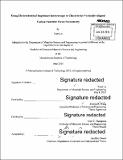Using electrochemical impedance spectroscopy to characterize vertically-aligned carbon nanotube forest porosimetry
Author(s)
Lu, Yuan, S.B. Massachusetts Institute of Technology
DownloadFull printable version (4.821Mb)
Other Contributors
Massachusetts Institute of Technology. Department of Materials Science and Engineering.
Advisor
Evelyn N. Wang.
Terms of use
Metadata
Show full item recordAbstract
Carbon nanotubes have generated much research interest and potential applications due to their unique properties such as their high tensile strength, high thermal conductivity, and unique semiconductor properties. Vertically-aligned carbon nanotubes (VA-CNTs) have been used in applications for electrochemical systems in energy storage systems and desalination systems. Typical methods of characterizing the morphology and composition of CNTs are limited in providing information on the packing density of CNTs, and therefore, an effective method for in situ characterization of VA-CNT electrodes is needed. This method explores the use of impedance spectroscopy and other electrochemical methods to characterize VA-CNTs in situ. VA-CNTs forests were grown via chemical vapor densification on pre-oxidized silicon wafers, mechanically densified to achieve varying volume fractions (1%, 2%, 5%, and 10%), and tested in a three-electrode electrochemical cell. Electrochemical techniques (cyclic voltammetry, impedance spectroscopy, and potentiostatic techniques) were used to measure the performance of the VA-CNTs in 1 M and 500 mM electrolyte solutions. Optimization of the experimental setup design and data collection methods yielded data that resulted in the expected cyclic voltammetry response and impedance behavior of porous electrodes. A transmission line model-pore size distribution (TLM-PSD) model was applied to the data collected in order to predict and model porosimetry characteristics. Porous behavior was observed in the VA-CNT electrodes of all volume fractions tested, and the impedance spectra showed that the volume fraction affected the overall impedance but not the characteristic shape of the spectra. Comparison between the impedance data collected in 1 M NaCl and 500 mM NaCl showed the expected corresponding inverse correlation with solution conductivity. Parameters that describe the VA-CNT electrode porosity were calculated and predicted using electrochemical data and the TLM-PSD model. The porous volume Vtot and total ionic conductance Yp values calculated using the model applied to the impedance spectroscopy data showed trends as expected for the different volume fractions of VA-CNT. The results show that electrochemical impedance spectroscopy can be used to characterize certain physical characteristics of the VA-CNT electrodes and further development of the model can yield insights into the porous geometry of VA-CNT forests.
Description
Thesis: S.B., Massachusetts Institute of Technology, Department of Materials Science and Engineering, 2015. Cataloged from PDF version of thesis. Includes bibliographical references (pages 55-56).
Date issued
2015Department
Massachusetts Institute of Technology. Department of Materials Science and EngineeringPublisher
Massachusetts Institute of Technology
Keywords
Materials Science and Engineering.